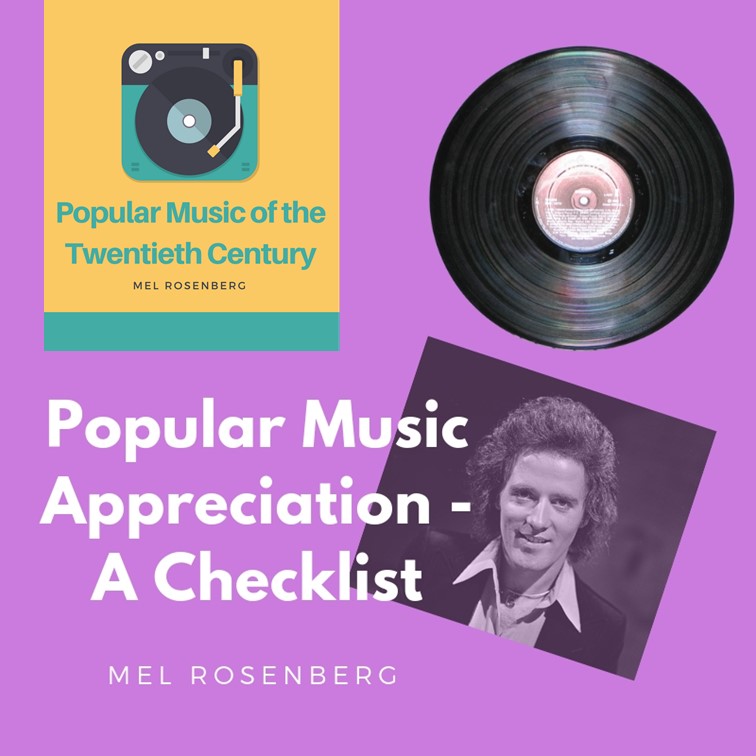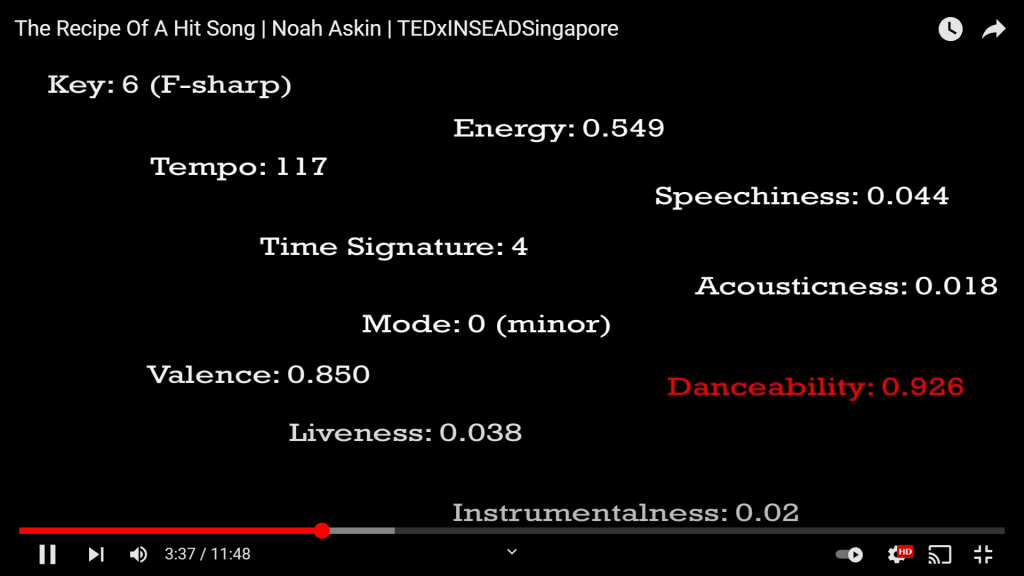
When we say a song is ‘memorable’ what do we mean? What elements keep playing in our ears and why? What makes us feel strong emotions when we hear it? Why do some songs seem to last forever? What is the secret sauce?
What makes for an amazing song? Similar but different? Do you agree with Noah Askin? See also
https://towardsdatascience.com/what-makes-a-song-likeable-dbfdb7abe404
Here are his ‘variables’ for Billie Jean. Is danceability king?

But we love Beatles songs that we can’t dance to, and old swing songs that we never learned to dance to. Until now!
Please read in case there is a question.
An important one! HENNION talks about the successful song as a combination of many parameters, creating stories that draw us in.
Here are the main points that Hennion discusses (scroll down to read all:
I found this nifty article by Antoine Hennion in the book “On Record” edited by Simon Frith and Andrew Goodwin, 1990, published by Routledge, page 185. He deconstructs the formation of the pop song. For him, the tune and simple melody are not the secret, but rather the arrangement, voice, colors, orchestration, recording and sound mixing that make the song. But as passive musical listeners, what we ‘hear’ and think we appreciate is the tune itself.
Lyrics: (with my own thoughts strewn here and there). The popular song tells a two or three minute story, a novelette, which borrows from poetry, the theatre, storytelling. The basic idea is set out, elaborated upon, and concluded. Often, there’s a conflict. The story is usually conventional, fits in the culture and mythology of the day (e.g., honeymoons). The words should give the text originality, yet simple to pronounce and memorize.
Character: Oftentimes, the singer is the CHARACTER in the song. He is the one on the bus waiting for the yellow ribbons (or knocking three times on the ceiling). Is his/her real character important here or just how he/she sings the song?
The “Mixture”: The music, lyrics and character have a subjective relationship that is hard to predict, coming together to create a successful song in which both the observer and (sometimes) the producer cannot analyze. The public, after all, wants to like a song and can forget the shortcomings of one or the other elements if they are somehow buoyed in the mixture.
Songs, like stories (and perfumes), have beginnings (intros), middles and ends.
Form of the song: Introduction – A few bars that enable the listener to identify the song immediately, a signal that says ‘Watch it, here comes such and such a tune!”. If successful, it is a hook that draws the listener in. Listen to the introduction of a few of these sixties tunes. How long does it take you to identify the song? How do they differ?
And here is my recent discussion with none other than Dr. Noah Askin about what makes a popular anything. Listen to what he has to say about the song as a ‘story triangle’.
It’s not just the story that the song recounts,
It’s not just the story around the song,
It’s also what the song does to you. Does it enter your ‘favorite library’? Do you want to play it at your wedding and share it with the world?
Noah calls this the ‘story triangle’.
Hold on! Story Triangle? Didn’t Aristotle talk about that 2400+ years ago?
Ethos is about establishing your authority to speak on the subject, logos is your logical argument for your point and pathos is your attempt to sway an audience emotionally.
Important: if a song is a story, it needs a great beginning:
Read
Includes Bing vs. Billie
We should also listen carefully to Disney and their secrets, on:How to write your own Disney song:
Techniques that Make Disney Songs Uniquely Disney and Great
Story that moves you from A to B
“I want” something – song types – intro, villain song,
work songs
they do more with less:
cut down on chorus – more info, more story
less repetition and repeated elements, more unique words
changes in tempo and meter
e.g. in ‘be our guest’- five different tempos
double the number of chords in a song
more key changes
Creating empathy in a story is critical- is it any different for popular songs (scroll down for full list)
-
Displaying a valued trait such as loyalty, love, or courage. …
-
Particularly good at something. …
-
Treated unjustly. …
-
Wishing for something universally understood. …
-
Thrust into danger. …
-
Thrust into grief. …
-
Caring for others, especially at a cost to oneself. …
-
Unique, attention-getting.
-
Overcome an inner fear or make a change
-
Facing an inner struggle
Can you think of a song for each of these sentiments?
Is it the song itself or how it is delivered? Originals vs. covers
Simple vs. Complex. Just how intricate a song and its arrangement can be! A great video for musicians especially. “And in the End” from Abbey Road. Listen to the harmonies from 1:33.
And here’s a complex song with a story that has lasted in English, Hebrew, and more!
Why do you think Paul McCartney chose these covers? Kisses on the Bottom, Paul McCartney, 2012
| No. | Title | Writer(s) | Length |
|---|---|---|---|
| 1. | “I’m Gonna Sit Right Down and Write Myself a Letter“ | Fred E. Ahlert, Joe Young | 2:36 |
| 2. | “Home (When Shadows Fall)“ | Peter van Steeden, Jeff Clarkson, Harry Clarkson | 4:04 |
| 3. | “It’s Only a Paper Moon“ | Harold Arlen, E. Y. Harburg, Billy Rose | 2:35 |
| 4. | “More I Cannot Wish You” | Frank Loesser | 3:04 |
| 5. | “The Glory of Love“ | Billy Hill | 3:46 |
| 6. | “We Three (My Echo, My Shadow and Me)“ | Sammy Mysels, Dick Robertson, Nelson Cogane | 3:22 |
| 7. | “Ac-Cent-Tchu-Ate the Positive“ | Harold Arlen, Johnny Mercer | 2:32 |
| 8. | “My Valentine” | Paul McCartney | 3:14 |
| 9. | “Always“ | Irving Berlin | 3:50 |
| 10. | “My Very Good Friend the Milkman” | Harold Spina, Johnny Burke | 3:04 |
| 11. | “Bye Bye Blackbird“ | Ray Henderson, Mort Dixon | 4:26 |
| 12. | “Get Yourself Another Fool” | Haywood Henry, Monroe Tucker | 4:42 |
| 13. | “The Inch Worm“ | Loesser | 3:43 |
| 14. | “Only Our Hearts” | Paul McCartney | 4:21 |
Why do you think Diana picked davka these songs for her cover album?
Diana Krall, 2017, Turn up the Quiet
Scroll down to see all.
| No. | Title | Writer(s) | Length |
|---|---|---|---|
| 1. | “Like Someone in Love“ | Johnny Burke, James Van Heusen | 3:16 |
| 2. | “Isn’t It Romantic“ | Lorenz Hart, Richard Rodgers | 4:28 |
| 3. | “L-O-V-E“ | Milt Gabler, Bert Kaempfert | 4:21 |
| 4. | “Night and Day“ | Cole Porter | 4:38 |
| 5. | “I’m Confessin’ (That I Love You)“ | Ralph Edward Daugherty, Al J. Neiburg, Ellis Reynolds | 3:24 |
| 6. | “Moonglow“ | Edgar Delange, Will Hudson, Irving Mills | 5:15 |
| 7. | “Blue Skies“ | Irving Berlin | 4:38 |
| 8. | “Sway“ | Norman Gimbel, Luis Demetrio, Traconis Molina, Pablo Rosas Rodriguez | 6:12 |
| 9. | “No Moon at All“ | Redd Evans, David Mann | 4:06 |
| 10. | “Dream“ | Johnny Mercer | 4:04 |
| 11. | “I’ll See You in My Dreams“ | Isham Jones, Gus Kahn | 3:53 |
| Total length: | 48:15 | ||
Let’s summarize:
Is it similar to other songs we know and like, familiar and yet different?
How are the lyrics? Do they make a tight fit the music?
A twist? Signs of genius in the words, music, instrumentation? A hook that draws us in?
Danceability/Beat/Groove/ ‘moveability’
Energy
Does it fit a particular situation/mood?
Does it make us feel like everyone else -OR-
Makes us feel part of a special group of people?
Is the tune ‘catchy’? Is it simple and easy to sing along to (short words, long vowels, convenient range, repetition) -OR- Is it complicated (lyrics, chords and chord progression, range, structure, modulation, etc.)?
Words – easy to pronounce and sing? Gibberish? Do they have meaning? Do they need meaning? Do they have irony, humor?
What about the singer?
Quality of voice and type of singing – timbre, range, speechiness, etc.
Does the song sound authentic?
Pitch, Melody and Phrasing (see opposite)
Vocal harmony
Persona of singer
Does the song tell a story? Is it a story? Does it become MY STORY?
Here is a list made by one of our classes!
Danceability – moveability
Broad agreement
Familiar rhythms?
Words, cleverness
“Hook”
Feelings – love, loneliness, abandon
Empathy for the character
Makes you feel like a part of group
Similar but different
Covers that revive it (but why choose them as covers?)
Musical tricks, such as key changes
interactiveness (getting the listener to do something)
speechiness (the song sounds like the singer is talking)
production, advertising and marketing – the money issue
singer and voice
humanness, passion, integrity, authenticity
Melody, harmony, instruments, effects, orchestration
The story
1. הסכמה רחבה
2. ריקודניות, תנועתיות (danceability)
3. מקצב (מוכר)
4. מילים – שנינות
5. Hook
6. רגש – אהבה, בדידות, אכזבה, שמחה
7. אמפתיה
8. להרגיש חלק מקבוצה
9. דומה אבל שונה
10. קאברים
11. טריקים מוזיקליים (KEY CHANGES)
12. פרסום
13. דיבוריות
14. תשוקה
15. אנושיות
16. כנות
17. אותנטיות
18. סיפור
19. אינטראקטיביות
20. הזמר והקול
21. תזמור
Some musical principles covered during the course:
2-4 and 4-4 time
AABA (32 bars)
Waltz (one-two-three time)
Rhythm Changes (e.g. Flintstones)
Stand By Me chords (The Fifties Progression)
Major and minor scales
The octave and notes on the scale
Musical hooks (anything that hooks you)
Blues (we talked about the standard 12 bar variety)
Chords
Notes
Relativity of music (playing songs in different keys)
Let’s now add pitch, melody and phrasing, as described here. Recommended, not for exam
And then of course there’s the question of whether the whole equals the sum of the parts. And whether the success of a popular song might sometimes defy ‘objective’ or ‘rational’ explanation. Recommended, not for exam.
Published: Nov 20, 2018
Latest Revision: Jan 1, 2023
Ourboox Unique Identifier: OB-531529
Copyright © 2018








